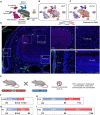Wnt1's Differential Effects on Craniofacial Bone and Tooth Development
- PMID: 40454459
- PMCID: PMC12508500
- DOI: 10.1177/00220345251336191
Wnt1's Differential Effects on Craniofacial Bone and Tooth Development
Abstract
The development of craniofacial bones and teeth relies heavily on the Wnt signaling pathway, yet the specific mechanisms and Wnt variants involved remain under continual investigation. Using publicly available single-cell sequencing data from the mouse incisor, we reveal Wnt1 expression across dental structures and investigate its role using a Col1a1-dependent Wnt1 transgenic mouse model. Inducing Wnt1 early on affects craniofacial bone without disturbing tooth development, but prolonged embryonic induction leads to postnatal mortality with osteopetrosis-like bone overgrowth and malformed teeth. While tooth formation was initially unaffected by postnatal Wnt1 induction, prolonged activation impaired tooth root formation and odontoblast differentiation, resulting in shortened roots and thinner dentin. Three-dimensional micro-computed tomography quantification reveal that both embryonic and postnatal activation of Wnt1 significantly increase neural crest-derived craniofacial bone volume, whereas mesenchymal-derived craniofacial bones are unaffected. Importantly, osteoclastogenesis is suppressed by Wnt1 in a dose-dependent manner, revealed through bulk RNA sequencing and in vitro experiments. These findings emphasize the differential effects of Wnt1 on bone development based on origin and highlight its role in modulating osteoclast activity, indicating broader implications for craniofacial development and potential therapeutic avenues.
Keywords: Wnt1 activation; enamel; osteoanabolic; osteoclastogenesis; osteopetrosis-like pathology; transgenic mouse model.
Conflict of interest statement
Declaration of Conflicting InterestsThe authors declared no potential conflicts of interest with respect to the research, authorship, and/or publication of this article.
Figures





References
MeSH terms
Substances
LinkOut - more resources
Full Text Sources
Miscellaneous

